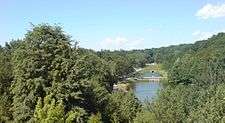Feofaniya
Feofaniya (Ukrainian: Феофанія; also called Theophania) is a park located in the historical neighborhood on a tract near the southern outskirts of Kiev, the capital of Ukraine. The neighborhood is located in the administrative Holosiivskyi Raion (district) amidst the neighborhoods of Holosiiv, Teremky, Pyrohiv and Khotiv. The park's total area is about 1.5 km2 (0.58 sq mi). The first Soviet computer, MESM, was built in Feofaniya.
| Feofaniya | |
|---|---|
 The Feofaniya Park, with St. Panteleimon's Convent looming in the distance. | |

| |
| Type | public city park |
| Location | Holosiiv Raion |
| Nearest city | Kiev |
| Coordinates | 50°20′27″N 30°29′13″E |
| Created | 1992 |
| Founder | government |
| Etymology | bishop Feofan |
| Operated by | National Academy of Sciences of Ukraine |
| Status | Monument of Garden Artistry |
IUCN category III (natural monument or feature) | |
| Website | The Official Site of Feofaniya park |

Feofaniya was first mentioned in 1471 as Lazorivschyna (Лазорівщина), which at the time belonged to an owner named Khodiki.[1] The name is said to derive from a monk named Lazar. In the 17th century, the area was referred to as Shakhravschyna (Шахравщина).[2]
The modern name Feofaniya dates back to 1803 when Feofan Shiyanov settled in the area, set aside for charity purposes. During the 1860s, Feofaniya belonged to the St. Michael's Golden-Domed Monastery in central Kiev. Buildings built in the area were constructed in the Ukrainian Baroque style, however, they did not survive.[2] In 1919, Feofaniya was converted to the Soviet state farm, and later transformed into the main observatory for the Institute of Botany of the Ukrainian Academy of Science.
In 1972, Feofaniya was declared a park, and from 1992—a government designated park, which belongs to the "Feofaniya" conservatory of the National Academy of Science of Ukraine. Reconstruction work began on the area in 2004,[3] which, when finished (projected in 2008) will include new landscaping, water and canal features.[4][5]
Located near Feofaniya are the St. Panteleimon's Convent,[6] the Nikolay Bogolyubov Institute of Theoretical Physics,[7] and the Government Clinical Hospital "Feofaniya."[8]
Objects of interests
- St. Panteleimon's Cathedral
- Feofaniya Clinic (State Administration of Affairs)
- Feofaniya Park (National Academy of Sciences of Ukraine)
- Boholyubov Institute of Theoretical Physics (National Academy of Sciences of Ukraine)
- Main Astronomical Observatory (National Academy of Sciences of Ukraine)
- Khotiv hillfort of Scythian times (6th century BC)
References
- "Feofaniya". Wiki-Encyclopedia Kiev (in Ukrainian). Retrieved 2008-02-13.
- Kudrytskyi, A. (1981). Kyiv, Encyclopedic Directory. Kiev: Ukrainian Soviet Encyclopedia. p. 649.
- Laws of Ukraine. Decree of the Cabinet of Ministers No. 654-р: Про затвердження ескізного проекту реконструкції та благоустрою парку - пам'ятки садово-паркового мистецтва загальнодержавного значення "Феофанія". Adopted on 2004-09-08. (Ukrainian)
- "Kiev park "Feofania" plans to finish reconstruction works in 2008". podrobnosti.ua (in Russian). August 15, 2006. Archived from the original on 2008-02-21. Retrieved 2008-02-13.
- Hryhorenko, Olga (July 17–23, 2004). "Feofaniya — the new "Tsar's Village"?". Mirror Weekly (in Ukrainian). Archived from the original on August 2, 2012. Retrieved 2008-02-13.
- "Saint-Panteleimon Women's Monastery in Feofaniya of Kiev". feofaniaskit.kiev.ua (in Russian). Archived from the original on 2008-02-20. Retrieved 2008-02-13.
- "Institute for Theoretical Physics". bitp.kiev.ua. Retrieved 2008-02-13.
- "Clinical Hospital "Feofaniya" of the Government Authority on Health". Government Authority on Health (in Ukrainian). Archived from the original on 2008-02-14. Retrieved 2008-02-13.